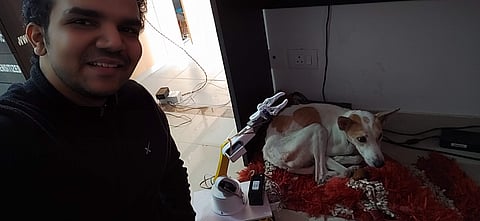

Whoever said anything is possible with technology, they are definitely correct. Here's a robotics scientist from Lucknow, who created a robot that can feed and take care of his dog when he isn't around. Milind Raj, also known as the Drone Man of India in various circles, recently created an manual-cum-automatic robot that is capable of feeding his physically impaired rescue dog.
"I found her during the lockdown when I stepped out for the drone sanitisation process in my neighbourhood in Lucknow. I spotted her lying inside a dry drain. Since it was a complete lockdown there were no vets or hospitals easily available, I decided to take her in. Her condition was quite critical and after observing her for a few days I realised that she behaves weirdly and was not like other regular dogs. I got a doctor's appointment and it was confirmed that she is visually impaired, cannot hear and is also mentally challenged. She must have been a victim of abuse, extreme beating which led to her condition and she is tremendously scared of humans or even their touch. I named her Jojo. She refused to eat if there were any human beings around. She was more comfortable living alone without anyone present around her. So, the only option I had in my mind was to design a robot that could feed the special dog and take care of her," explains Milind.
It took him around a month to create the robot for her. "Jojo understood that the robot is incapable of hurting her. The robot can be operated manually and also in automatic mode. The robot serves food three times a day. It has seven BDC-Motors, a dedicated power system with a large amount of intricate work to make it operational. It works on an open-source platform and is built of PLA material used in a 3D printer. The robot can stay up for 12 hours upon one single charge cycle. The robot can move around from place to place without spilling food. It can carry almost every type of food for the dog and serves it to her. Jojo is now living with the robot for 7 months and she is gradually recovering," he adds.
READ ALSO: A man, his wife, two dogs and a three-legged kitten: This is the unbelievable story of one family's journey to the Himalayas in a Tiago
In 2018, Milind had also created a drone with a special robotic arm that rescued out a puppy trapped inside a deep drain. "Every day I feed hundreds of animals living on the streets. A nation’s moral score is judged by the condition of life of animals living on the street, and that's something India lacks. We need to change for a better tomorrow, we need to be compassionate for other species," quips the robotics scientist.
Milind is also known for his drone prototype during the outbreak of the Coronavirus that can carry seven to 10 litres of disinfectants that can operate through the transmitter, mobile or computer and can be used for effective sanitisation across large spaces. "It can travel to a distance of 6-8 kilometres and spray sanitiser inside really narrow lanes. One person can control and fly the drone keeping a safe distance and doesn't have to go to those places physically. It has ultrasonic sensors, navigation sensors and won't crash in narrower spaces," explains Milind. He has also founded a robotics company called Roboz.in which creates robots to solve day-to-day human and animal problems.
In December 2014, Milind met the former President of India, Dr APJ Abdul Kalam and the title Drone Man of India was bestowed upon him by the Missile Man. Milind completed his graduation in Computer Science at the Massachusetts Institute of Technology and came back to Lucknow to pursue a specialisation course on Air and Space Law. Milind also takes out time to teach underprivileged kids in and around his neighbourhood. "I have around 700 students now who I teach absolutely free of cost. I teach them the basics of science, mostly from the age of five years to 15 years," he concludes.
